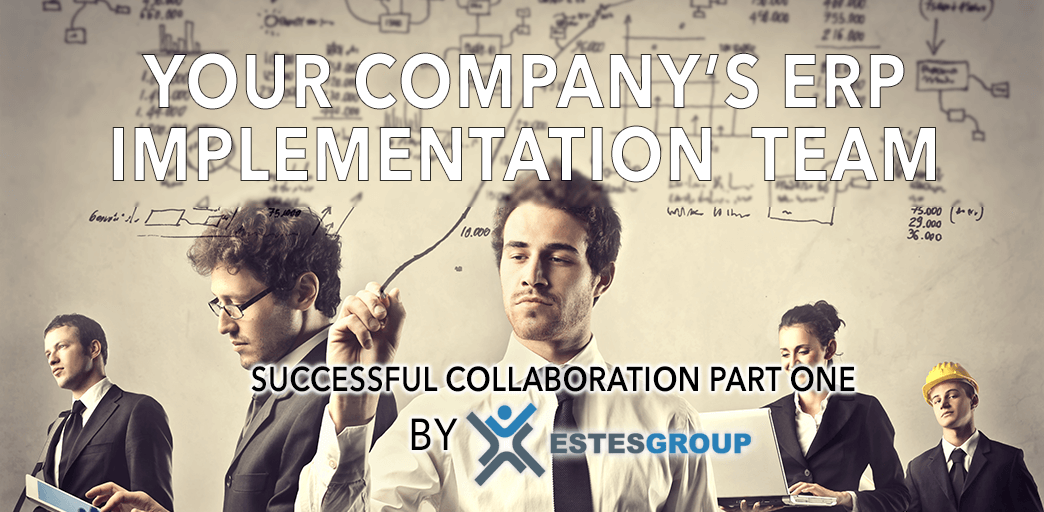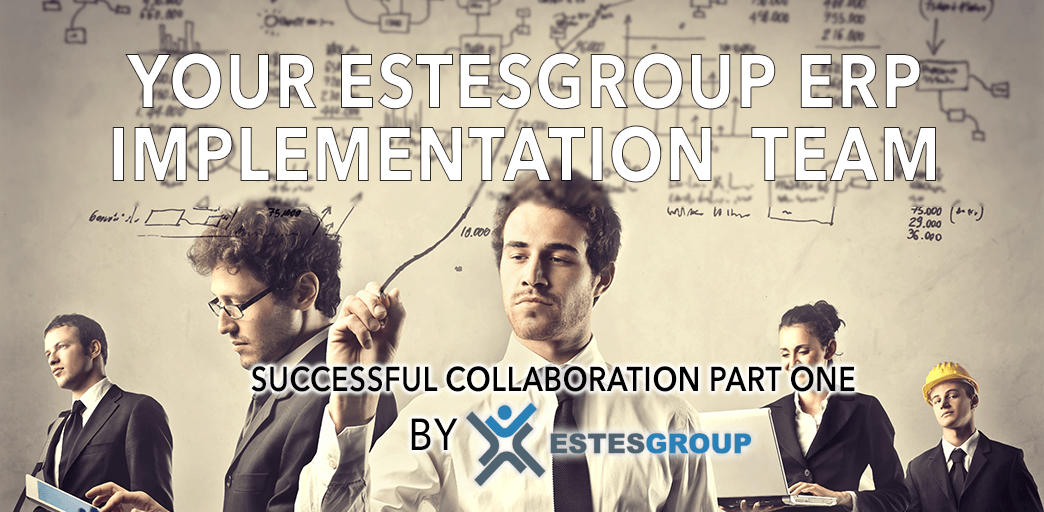No Results Found
The page you requested could not be found. Try refining your search, or use the navigation above to locate the post.

Click here to read more about EstesGroup’s side of ERP implementation methodology.
In Part One of this blog for ERP system implementation tips, we outlined the Estes Group specialists we will assigned to your ERP implementation, and the specific roles they will play to ensure success of your project.
But as we’ve said, every project is a partnership — a meeting of minds, specialities, and expertise from your company and ours are what make a successful ERP collaboration strategy.
So who are the people we hope to work with from your enterprise? What will their ERP implementation roles and responsibilities be in creating the most effective implementation of your chosen ERP solution?
For our ERP collaboration strategy, we always prefer that our clients have a well-informed Project Sponsor who takes an active role in your implementation project. Your Project Sponsor is almost always a company executive: the CEO, CFO, or President. Ideally, this person sees your ERP implementation as we see it: the best opportunity for your enterprise to retain or advance its competitive edge in your sector.
Over the years, we’ve managed to accumulate a lot of success stories at EstesGroup. By far the best and most frequent success stories share a common, pivotal character. They all have a client-side Project Sponsor with a clear and specific future state vision. Someone who’s as excited to implement your chosen ERP solution as we are.
We’ve noticed a huge difference between clients with active, interested implementation sponsorship and more laid back approaches. One of the best ERP system implementation tips we can give is that the active, interested Project Sponsor sets the tone for the entire implementation. His or her energy becomes contagious. The encouragement, guidance, resources and advocacy they provide is invaluable.
Your Project Sponsor will chair your project’s Steering Committee, which is typically comprised of executives from VP to C-level. Responsibilities of the Steering Committee include:
Your team will also have a Project Manager tasked with synchronizing all the various moving parts of your ERP implementation. Your Project Manager shoulders the bulk of the day-to-day work required to make your implementation successful. His or her specific responsibilities include:
Responsibilities of your Customer Core Team members include:
Click here to read about successful ERP collaboration with both teams.

You’ve probably heard that it takes two to tango. And you know what that means:
A successful working relationship requires that each partner works toward a common goal, and understands which tasks they’re individually responsible for so the team can meet that goal.
Effective collaboration can only occur once these two conditions are met.
So what are the responsibilities we expect from your implementation team and ours in terms of developing a successful ERP implementation methodology?
Let’s first deal with roles and responsibilities for the EstesGroup side of our ERP implementation team strategy.
Your enterprise will always enjoy the direct involvement of our Vice President of Professional Services, who will always have one simple but important responsibility: to make sure that your firm becomes an enthusiastic reference for other prospective customers.
We want your project experience to be so good that you run out and tell all your peers about what great work we did. That our ERP implementation methodology broke down all the growth barriers you were experiencing and took all the pain out of your ERP implementation. Over the years, we’ve found that, when we guide our actions by this simple northstar principle, everything else that must happen to create a successful ERP implementation team strategy falls into place.
As part of our ERP implementation team strategy, your implementation will be led by our hand-picked Project Manager on a day-to-day level. The Project plays a very important role. He or she sets the ERP implementation methodology beat to which both your implementation team and ours will march toward success.
A big part of his or her job is keeping your team several steps ahead of the ERP implementation methodology. Doing this allows you to participate more fully in the ERP implementation. In the long run, it also saves time and creates a less ambiguous, more enjoyable. project environment.
Specific responsibilities of your Project Manager include:
Specific responsibilities of your Customer Core Team members include:
Click here to read:
SUCCESSFUL COLLABORATION PART TWO:
YOUR COMPANY’S IMPLEMENTATION TEAM

Essentially, HIPAA enshrines the means by which American workers and their dependents can keep their health insurance coverage should they change or lose their jobs.
HIPAA also sets industry-wide standards for electronic billing of health care services. Additionally, this law mandates the confidential handling of an individual’s medical information.
So what does this have to do with mobile devices? Plenty.
Mobile devices have affected every industry sector. With each passing day, more and more professionals conduct their business using tablets, laptops, or smart phones. This includes the medical industry. Doctors, nurses, and physician’s assistants routinely send confidential (HIPAA) data over satellite data plans and WiFi.
In most cases, the medical industry’s use of mobile devices translates into better patient care. But it also opens personal medical data to the threat of cyber theft.
To maintain HIPAA compliance, health care professionals and IT managers should implement the following best practices when handling health care data on mobile devices:
Make sure to document the fact that your patients have signed off on communicating with your office via email or any other electronic means. Documented consent is critical to HIPAA compliance. It’s also one of the simplest and best ways to avoid embarrassing misunderstandings and potential legal suits down the line.
The ease and speed of mobile devices often results in users relying on abbreviations, emoticons, and other forms of internet vernacular. Put simply: DON’T DO THIS. Due to the nature of the field, any HIPAA data created should be kept appropriate for long-term records. Remember that communications, notes, and files that appear unprofessional can subject health care practitioners to confusion at best and malpractice suits at worst. Treat every character you type on behalf of your job as the valuable work product it is. Your company and the patients you treat depend on accurate communications scripted in proper industry vocabulary.
Remember that every email you send or receive, every file you upload or download, every conversation you have by phone is part of your patient’s official medical record. Text messages, phone calls, and conversational asides might not seem important in the moment. However, they all form a piece of the overall puzzle a patient’s profile presents. Be sure to record every instance of communication diligently to prevent confusion and delays in treatment, as well as to maintain HIPAA compliance.
No one leaves for work each day while the door to the house stands open wide. That’s just common sense. By the same token, no one using a mobile device in the 21st century should send any transmission without securing that message via data encryption. User passwords activate only one tier of proper data security. DON’T STOP THERE! Due to the sensitivity of medical information, add as many layers as you can in the form of personal questions, icons, PINs, and other challenge-response tests. Remember that there’s no such thing as too much security.
Our ComplianceCare service from EstesCloud can help you solve all of your HIPAA IT issues.
Get more tips on protecting HIPAA data on mobile devices with our comprehensive advice on remote worker security. Because mobility increases the risk of cyberattacks, our helpful IT security guides can keep your employees and clients safe. Fill out the form below to receive a presentation on remote workforce security. This presentation was an event in partnership with the Loveland Chamber of Commerce. EstesGroup’s headquarters is in Loveland, Colorado, where we help small and midsize businesses deploy mobile cybersecurity solutions.

APM is an IT solution created to extend automated, flexible delivery of important documentation in paperless (i.e. digital) form, most commonly via email or FTP, depending on your customer’s druthers.
APM was constructed as a scalable, modular tool that can be implemented out-of-the-box. It augments other forms of automatic report routing to include enhanced functionalities such as Scan-link, the creation and dispersal of supplemental documentation, and document repository actions.
Lots of enterprises were built on APM, but APM presents increasingly onerous limitations, specifically when paired with cloud-based applications, which have become the new norm. The Software as a Service (SaaS) model implies that most of a system’s key components are no longer hosted on one machine but distributed over multiple virtualized systems. In this environment, applications often migrate from one system to another to meet service level demands while dealing (as needed) with periodic outages.
Thankfully, Epicor 10.1 presents a fine solution whose secret lies in the software’s routing rules.
Using the report writing functions of Epicor 10.1, users can create their own custom routings.
With Epicor 10.1, you can define whichever routing rules you like to generate, print, and distribute any output via whatever means you choose. You instruct Epicor 10.1 to distribute these materials to your chosen recipient sets automatically.
The ability to set your own routing rules means that your enterprise can now address the various needs unique to your business. That means generating reports targeted specifically at customers sets, suppliers, and – importantly – your own internal users.
Report Routing functionality is central to Epicor’s architecture. It allows you to decide when and how your customers receive communications.
(Previous versions of Epicor offered basic routing options, and these features are still available for backwards compatibility with older reports.)
JOIN US FOR A SPECIAL EPICOR ERP 10.1 WEBINAR JANUARY 19th
The page you requested could not be found. Try refining your search, or use the navigation above to locate the post.

In the dynamic landscape of enterprise management, Epicor 10.1’s Package Control feature emerges as a game-changer, offering your business the power to effortlessly track, manage, and transact groups through a unique identity code. This code becomes the backbone for bundling various items, creating a seamless workflow for your operations. The Package Control feature in Epicor 10.1’s gives your enterprise the ability to track, manage, or transact a group via a unique identity code. Any items can be bundled to form a group.
Package Control also lets you track any item through various stages such as sales order picking, shipping transactions, job receipts, and inventory transaction. When everything is said and done, Package Control functionality hinges on two entities built into the Epicor 10.1 database. The first entity is properties and contents, meaning the package itself and specifically what the package contains. The second entity is known as the identifying label.
ID labels become particularly important in industries such as automobile manufacturing. It’s important to know that each entity can have its own lifecycles for identity and process. Each entity can also possess unique rules for control, process flow, and status. These rules need not be exclusive to each other. If it suits the workflow of your enterprise, entities can share rules.
The key to all this is the PCID or Package Control ID field, which is maintained at the site level. PCIDs can operate as single level or multi-level (also known as nested) fields. As a general rule, single level PCIDs hold sway over individual parts while multi-level PCIDs might contain individual items or cluster of PCIDs. Additionally, each PCID can be classified as static or dynamic. Static PCIDs are associated with containers that are available for reuse while dynamic PCIDs are tagged to those items that can be placed on containers that collapse after shipment and cannot be repurposed (i.e., a shipping box).
As with so many other features of Epicor 10.1, customization becomes the prime differentiator. Rule sets for Package Control are flexible enough that your enterprise can “teach” Epicor 10.1 to work with what works best for you, not the other way around.
Package Control in Epicor 10.1 operates like the license plate system to register cars – but with vastly more capacity to designate and manage your groups. With Package Control, you define each package and its contents. You input, track, and manipulate pertinent data points such as serial numbers and part codes. Once that’s done, the rest is easy. You can move each group wherever and however you like while enjoying full confidence that you have total visibility of the package’s contents.
With Package Control in Epicor 10.1, your company can finally move multiple products via container rather than scrambling to track movements on a part-by-part basis. Apart from saving you time and an alarming number of headaches, this new functionality opens a new frontier for industries in the automotive, aerospace, and medical sectors – to name just a few!
While Package Control functionality currently focuses on outbound groups in Epicor 10.1, the future is promising. Inclusion of Package Control for inbound groups is on the horizon with the upcoming Epicor 10.2 release. (Please note: Package Control functionality only works on outbound groups in Epicor 10.1. Package Control for inbound groups is currently slated for inclusion in Epicor 10.2.)